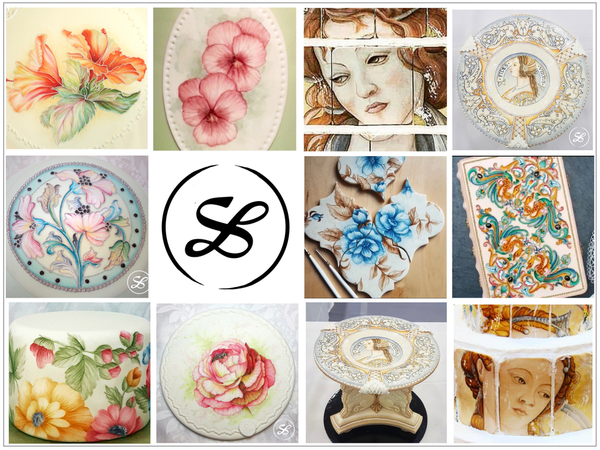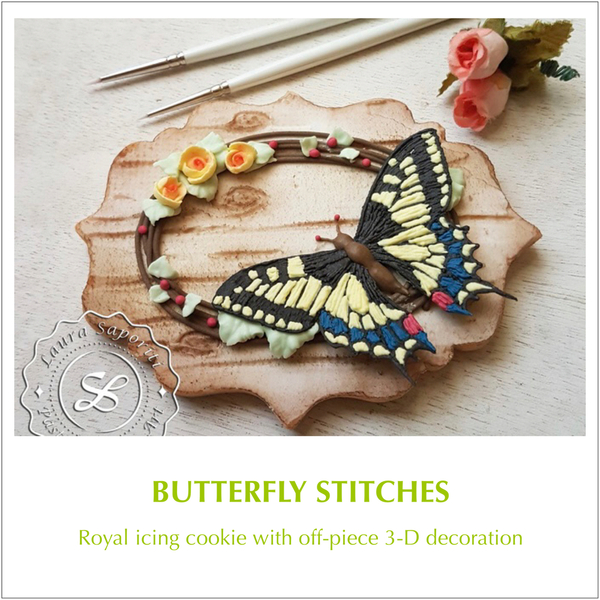Hi, everyone, and welcome to a new Watch-Learn-Create challenge! In this 53rd challenge, our featured guest @Laura Saporiti shares all of the tools, techniques, and tips needed to paint watercolor florals on fondant. Laura showcases her personal "watercolor veiling" technique by painting some lovely pansies in her demo. In her opinion, painting flowers is pretty forgiving, so they're a great way to start a painting challenge!
Important: Laura has the license to use the pansy illustrations that appear during the video demo. She paid a fee to secure that license, with these image references and credits: Illustration 39057452 ©️ Anemad |Dreamstime.com.
With her “veiling” technique, Laura is trying to mimic real painted watercolors on paper, though obviously her technique had to be adapted to water-sensitive fondant. She calls her method the "watercolor veiling" technique because she paints one thin layer (like a veil) on top of another layer in order to achieve a gradual layering of color. Laura's method, which she developed over the years, is just one approach to painting on fondant. There are, of course, a lot of different ways to simulate a watercolor effect, but there's no denying that Laura's approach is extremely effective. (Just take a look at some of her paintings below!)
Laura is an award-winning pastry chef and cake and cookie artist based in Italy who loves to travel the world sharing her passion, knowledge, and experience in the sugar arts. Laura has competed and placed in numerous shows and judged many international competitions. In fact, in 2020, she won first place in the 3-D Cookie category of Julia M. Usher’s Cookie Art Competition™, and, since then, Laura has been part of Julia’s judging team. (You can read Laura's complete bio under the pink link.) In the collage below, I have highlighted some of Laura’s work featuring watercolor paintings on fondant - not only florals, but also a number of very finely painted figures on cakes and cookies.
Topic
When you watch Laura’s demo, you will learn how to paint florals on fondant using a watercolor effect. Laura and I are challenging you to think of a unique way to use her "veiling technique" on a cookie project of your own design that is covered totally or partially with fondant. For this challenge, we will focus only on painting on fondant, as painting on royal icing could be the topic of a future challenge. You have plenty of time to get inspired and practice, as we are going to keep this challenge open until the beginning of April. Taking your own picture of a flower or flowers would be a good way to get inspiration.
And now, let’s take a look at Laura’s demo, but first . . .
Important: Laura's video was recorded exclusively for Cookie Connection for the sole purpose of helping Cookie Connection members develop their skills and apply those skills to this challenge and future projects of their own design. This video recording, and the content contained therein, cannot be used as material for cookie classes, for purposes of financial gain, or for any other purpose than stated above without obtaining written permission from Laura in advance. Thank you!
Below is a sneak peek of Laura's video. To gain access to the entire tutorial and associated resource list, click here, and you will be taken to Julia's business site, where you will need to pay a small fee in order to view the video. Note: A large portion of challenge video fees goes to our featured guests to compensate them for the time and costs associated with prepping these masterful classes. The remainder covers the costs of video production, editing, and hosting.
Again, you can access the entire video with resource list here, as well as read a complete description of the video contents.
Don't forget: If there is anything that you would like to ask Laura regarding the technique she has showcased, you can do so at any time in the comments under this post. Laura will be available to reply for the duration of the challenge.
Cookiers of all skill levels are encouraged to participate. Remember that this challenge is not a competition among cookiers, but rather a way to have fun and challenge yourself. The purpose is to stretch skills, learn, and try new things. That’s also why prize winners have always been determined through random drawings, and that’s why we encourage you to participate with multiple entries. All entries are eligible to win the prize drawing. And let me add . . . even if you are not the lucky winner, you will benefit from a great learning experience just by watching Laura’s demo, practicing her painting techniques, and creating an entry.
Prize
Now, about that prize! Laura is giving away one of her prerecorded online classes to the one entrant whose name, again, is drawn at random at the close of the challenge. Thank you, Laura!
Read more about the content of Laura’s online class here, or by visiting Laura Saporiti Pastry and Cake Art Online School.
Rules
The rules for participating are few and very simple. Please make sure you read them before you post your entry:
- Watch Laura's demo, get inspired, and challenge yourself to create a brand-new cookie project of your own design using Laura's "watercolor veiling" technique applied to a floral design on fondant.
- Your entry could be a set of cookies or even a single 2-D cookie covered totally or partially with fondant. You can also enter with a 3-D cookie project. You can use royal icing and other media/techniques to embellish your cookie/cookies, but the technique showcased by Laura, watercolor florals on fondant, should be the main feature. It should stand out - that is, it should be the first thing one notices when looking at your cookie entry. And, remember, florals should be painted on fondant (not royal icing).
- Your work (cookie project and floral design) must be original and not a copy of someone else’s work/design/art/image unless you obtained a license for the art and/or written permission from the author in accordance with Cookie Connection site rules and US copyright laws. All permissions received and accompanying art credits (similar to those shown for the pansies at the start of this post, including a link back to the source art) should be posted in a comment under your entry. HOWEVER, we would much prefer for you to take inspiration from nature or your own photos of flowers. Please always read Cookie Connection's photo posting guidelines before posting on the site.
- Please share in the comments under your entry what you learned, any difficulties you encountered and how you overcame them, and any suggestions to help and inspire your fellow cookiers. If English is not your native language and you feel more comfortable using your own language, you can. We will add translations if we can.
- Have fun!
To Enter
- If you have any questions for Laura as you are developing your entry, that's great! We encourage questions and learning at every step of the process. Please enter all questions in the comments area under this post, so that everyone can benefit from the Q&A. And please tag @Laura Saporiti so she is sure to see your question and respond in a timely way.
- Please post an image of your cookie project to the site under the Cookie Connection Challenge clip set no later than April 8, 2023 at 5 pm central time. (Yes, we are giving you lots and lots of time to create - 10 weeks!)
- Because these challenges will be ongoing, we ask that you put "Watch-Learn-Create Challenge #53" in your photo caption (subtitle field) AND in a tag, so we can tell the challenges apart from month to month. Please use the title field to uniquely name your cookies as you normally would.
- Please also assign other relevant clip sets and tags to your images, as you normally would. (Don't use just the Cookie Connection Challenge clip set and leave it at that, or your photos won't easily be found with keyword searches.)
- You can enter more than once, but please post only one clip of each distinct entry. Multiple clips of the same entry are not allowed unless added in a comment beneath the one primary clip.
On April 15, in our weekly Saturday Spotlight, I will reveal the 10 top-trending entries (as determined automatically by our site-trending algorithms*) as well as the randomly drawn prize winner. The next challenge will be announced soon after this challenge has closed. *Note: The site algorithms use members' collective likes, comments, and reactions to each entry to determine our Spotlightees.
If you are new to Cookie Connection and you need help posting your entry, please let me know and I’ll be happy to help you.
We can’t wait to see your creations!
Ciao, Manu (and Laura)
[EDITOR'S NOTE: Having previewed this video, I feel compelled to point out what a treasure it is, and to thank Manu and Laura profusely for the immense amount of time, thoughtfulness, and professionalism that went into it. It is a true gem, as are these two wonderful cookie artists and past guest @Evelindecora. If you have not yet participated in a challenge, please consider doing so - each is a generous gift from a rare talent. For all past challenge recordings - to see what you may have missed ![]() - please check out the Watch-Learn-Create Challenge playlist on my YouTube channel. ~JMU]
- please check out the Watch-Learn-Create Challenge playlist on my YouTube channel. ~JMU]

Manuela Pezzopane, affectionately called Manu by her friends and family, is the author of the blog feature Made by Manu, where each month she shares the method behind a magical cookie of her own making. In March 2022, Manu also assumed the role of host of our rebranded and reformatted Cookie Connection Challenges: Watch-Learn-Create Series, which debuted in a virtual video format in July 2022. A fan of everything handmade, Manu professes to have tried every possible hobby. However, it wasn’t until the end of 2014, when an American friend invited her to a Christmas cookie exchange, that she first discovered decorated cookies. In 2015, after watching Julia M. Usher's videos and signing up on Cookie Connection, Manu finally attempted her own designs. Since then, cookie decorating has become Manu’s passion, and her mesmerizing video shorts have earned her a large and loyal following throughout the global cookie community. Manu harks from Rome, Italy, where she currently resides. You can email Manu at manubiscottidecorati@gmail.com, follow her on Facebook and Instagram, or explore her past challenges and large library of Made by Manu tutorials here on Cookie Connection.
Photo credit: Manuela Pezzopane





Comments (38)